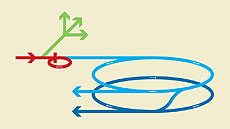Project X collaboration meeting Friday, Saturday

The most recent conceptual design for Project X proposes a 2-GeV
continuous-wave linear accelerator (straight red line). Most of the 2-GeV
protons would be used for various experiments with kaons and muons (green
lines), and the rest would be accelerated by a Rapid Cycling Synchrotron to
8 GeV (red ring). The 8-GeV protons could be stored in the existing Recycler
storage ring and delivered to experiments (light blue line), or they could
be transferred to the Main Injector accelerator for acceleration to 120 GeV
and the production of a high-intensity neutrino beam (dark blue).
A meeting this week at Fermilab may help decide the initial configuration of Project X, a proposed high-intensity proton accelerator complex that could provide beam for a variety of physics projects.
Roughly 85 people from 10 laboratories and institutions have registered for the workshop, which will take place in One West on Friday, Sept. 11, and Saturday, Sept. 12.
Steve Holmes, Fermilab's associate director for accelerators, will give an introduction to the project and an overview of the proposed project's strategic plan during the opening plenary session from 8:30-10:30 a.m. Friday. Registration for the workshop via the Web site is encouraged, but not required. Both staff and users are welcome to attend. The meeting will conclude with working group report sessions on Saturday morning.
During the meeting, collaborators will re-examine the first potential design plan for Project X, which includes an 8-GeV pulsed linear accelerator. They will also look at a second design plan, which proposes a continuous 2-GeV linac and rapidly cycling synchrotron. This plan could provide greater flexibility in the establishment of a varied physics program at lower energies.
"We want to get the collaboration engaged and help them understand the second configuration as a potentially viable option," Holmes said.
Hopefully, collaborators will offer critiques on the design alternatives during the meeting, Holmes said, so that they can move forward on a preferred design in 2010. The meeting will also allow collaborators to form an FY2010 work plan that outlines and assigns tasks.
The collaboration will look to the Accelerator Advisory Committee, which convenes mid-November, for technical advice on the proposed project's second design plan. Collaborators hope the project will receive CD-0 in 2010.
For more information on Project X, visit the proposed project's Web site.
-- Rhianna Wisniewski
|